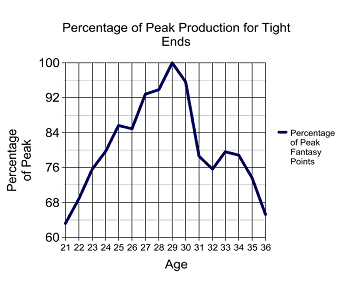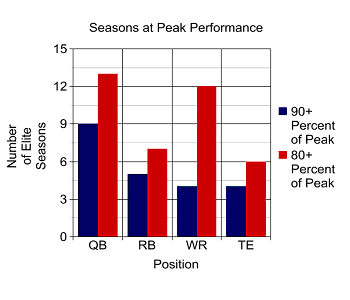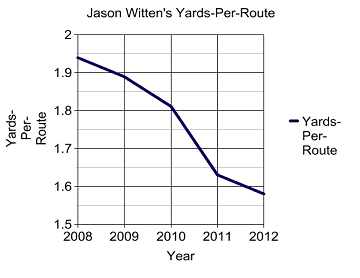Jonathan Bales is the author of the Fantasy
Football for Smart People book series. He writes for the New
York Times, DallasCowboys.com, NBC, and Dallas Morning News.
When I published Fantasy
Football for Smart People: How to Dominate Your Draft last
year, I didn’t really anticipate selling all that many copies.
I wrote it simply to put pen to paper on some draft strategy thoughts
I’d had over the years. Well, a few million (or thousand,
I can’t remember?) sales later, I have a whole lot of fantasy-related
research behind me and I’ve continued the series with two
new fantasy football books.
One of those books, What
the Experts Don’t Want You to Know, tackles 25 of
fantasy football’s most pressing questions. Do running backs
really break down after a lot of carries? Can injuries offer value?
Do players perform better in contract seasons? What’s the
typical age of decline for each position?
The latter question will be the subject of today’s post. Age
is one of the most influential factors in my projections, especially
for dynasty leagues, but most owners overlook it. If you know when
players at certain positions tend to break down, you can acquire
all kinds of value. Here’s a sample from a chapter on fantasy
football production by age for each position.
Below, I charted tight end production over
the past decade-plus, sorted by age.

If that graph were a mountain, it would be difficult to climb on
both ends. That’s because tight ends have historically had
a smaller range of peak years than quarterbacks, receivers, and
even running backs. Tight ends take a long time to develop—the
probability of a rookie tight end posting respectable fantasy numbers
is almost zero—and they see a steep decline in their early-30s.
Historically, the typical tight end has produced only four seasons
with at least 90 percent of his peak production. In that way, they’re
very comparable to wide receivers, who also record only a few elite
years. The difference is that wide receivers sustain a decent level
of play for a much longer time than tight ends.
But why? It’s possible that the wear and tear of playing the
tight end position takes its toll. By the time tight ends hit their
30s, they’re just worn out. That might change with the rise
of pure pass-catching tight ends who don’t have to deal with
the hassle of blocking, but it’s unclear right now.
To show you the small window of opportunity for the average tight
end, check out this graph.

This gives you a really good idea of the number of quality (80+
percent of peak) and elite (90+ percent of peak) seasons for the
average player at each position. Unsurprisingly, quarterbacks have
the longest windows with an average of 13 quality seasons. Meanwhile,
tight ends have the fewest quality seasons (six) and elite seasons
(four).
I think this information actually both helps and hurts tight end
value, depending what league you’re in. In dynasty leagues,
tight ends have to be downgraded since most of them won’t
provide you with long-term production. In redraft leagues, however,
the lack of tight ends playing at an elite level at any given time
could actually inflate their value. Remember, a fundamental concept
of sound fantasy football drafting strategy is scarcity; elite tight
ends are a scare (and surprisingly consistent) resource, meaning
they’re valuable.
So how should all of this affect your decision-making? Well, it’s
probably smart to target tight ends entering their mid-20s, whether
you play in a re-draft or dynasty league. It’s in that range
that most tight ends see a dramatic spike in play.
Outside of the fact that Gonzalez is a freak and you can probably
draft him until he’s 55-years old, you should really be avoiding
those aging tight ends. Most fantasy owners aren’t too high
on Gates, but Witten is the third tight end off of the board in
most drafts. That’s a problem. Actually, Witten’s decline
has been visible for a few years now, but not unless you know where
to look. While his bulk stats have been impressive, they’ve
coincided with an increase in workload in the Cowboys’ offense.
Take a look at Witten on a per-route basis.

Witten’s bulk stats are going to decline in the very near
future, and my thinking is that it will be this year. I won’t
own him in any leagues, and based on his ADP, you shouldn’t
either.
Fantasy owners need to know a lot of information, but it’s
the data they use that others aren’t that can lead to a competitive
advantage. Age is the most overlooked trait when projecting players,
so it isn’t much of a factor in ADP. Know the historic rates
and ages of decline for each position, and you can exploit that
inefficiency.
Buying
the books on Amazon or as a PDF
is your first step toward fantasy dominance.
|

